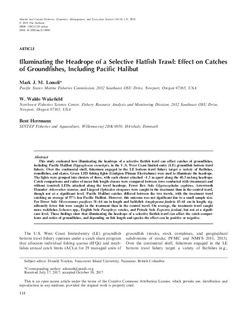Illuminating the Headrope of a Selective Flatfish Trawl: Effect on Catches of Groundfishes including Pacific Halibut
Journal article, Peer reviewed
Published version
Permanent lenke
http://hdl.handle.net/11250/2566979Utgivelsesdato
2018-03-30Metadata
Vis full innførselSamlinger
- Publikasjoner fra CRIStin - SINTEF Ocean [1369]
- SINTEF Ocean [1443]
Originalversjon
10.1002/mcf2.10003Sammendrag
This study evaluated how illuminating the headrope of a selective flatfish trawl can affect catches of groundfishes, including Pacific Halibut Hippoglossus stenolepis, in the U.S. West Coast limited‐entry (LE) groundfish bottom trawl fishery. Over the continental shelf, fishermen engaged in the LE bottom trawl fishery target a variety of flatfishes, roundfishes, and skates. Green LED fishing lights (Lindgren‐Pitman Electralume) were used to illuminate the headrope. The lights were grouped into clusters of three, with each cluster attached ~1.3 m apart along the 40.3‐m‐long headrope. Catch comparisons and ratios of mean fish length classes were compared between tows conducted with (treatment) and without (control) LEDs attached along the trawl headrope. Fewer Rex Sole Glyptocephalus zaphirus, Arrowtooth Flounder Atheresthes stomias, and Lingcod Ophiodon elongatus were caught in the treatment than in the control trawl, though not at a significant level. Pacific Halibut catches differed between the two trawls, with the treatment trawl catching an average of 57% less Pacific Halibut. However, this outcome was not significant due to a small sample size. For Dover Sole Microstomus pacificus 31–44 cm in length and Sablefish Anoplopoma fimbria 43–61 cm in length, significantly fewer fish were caught in the treatment than in the control trawl. On average, the treatment trawl caught more rockfishes Sebastes spp., English Sole Parophrys vetulus, and Petrale Sole Eopsetta jordani, but not at a significant level. These findings show that illuminating the headrope of a selective flatfish trawl can affect the catch comparisons and ratios of groundfishes, and depending on fish length and species the effect can be positive or negative.

